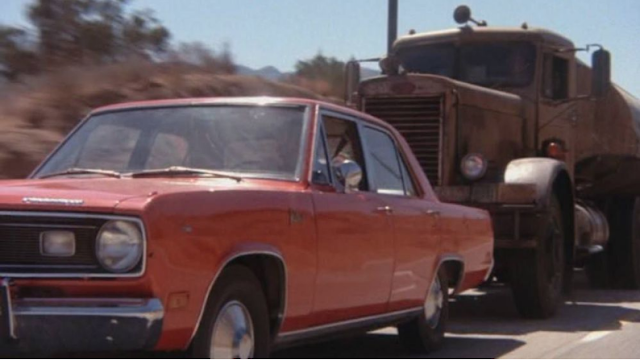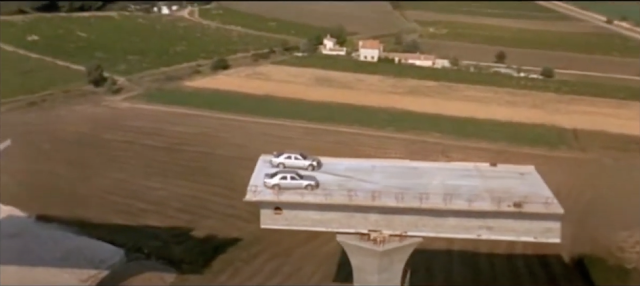When did a chase scene in a movie capture your imagination, and why? Was it in a thriller, a road movie, or a comedy? In what way was the chase essential? Did it seem to grow out of the plot or the needs of the protagonists, or did it just seem to be an excuse to keep you interested by staging crashes and blowing stuff up? Maybe your favorite chase scene was essential in another way, in that it pioneered a plot twist or an effect that hadn't been tried before. That, along with technical acuity, was one of the criteria that led to our 7 favorites. And we've listed another 5 also-rans after our faves, so that you can watch a different chase on each of the 12 Days of Christmas...
Bullitt (1968, directed by Peter Yates, USA) integrates its chase scene into a plot in which a mob witness under protection by police lieutenant Frank Bullitt (Steve McQueen) has been gunned down by some hitmen. When two guys with guns show up in a Dodge Charger 440 behind Bullitt's '68 Mustang 390 on the streets of San Francisco, the race is on to see whether the predators will become the prey. The chase was filmed on North Beach streets, with McQueen sharing driving duties with Bud Ekins, a Hollywood stunt driver. Solar Productions obtained permission from the mayor's office before filming, and hired extras from under-served neighborhoods at union scale. When Warner Brothers protested this approach and tried to save money by moving the filming to the studio lot, McQueen refused, and Warner cancelled a contract involving 5 more films. The box-office success of Bullitt probably made them regret this move. British director Peter Yates, of Robbery (about the Great Train Robbery) chase fame, mounted multiple compact cameras in the cars to provide enhanced immediacy. Unlike later filmed chases involving special effects or computer-generated images, it still feels fresh and real.
The French Connection (1971, directed by William Friedkin, USA): Director Friedkin's fictionalized account of the NYPD's efforts to nab French heroin smuggler Alain Charnier starred Gene Hackman as detective Popeye Doyle, and an eye-popping chase scene involving Doyle commandeering a Pontiac to apprehend a hood who has escaped onto an elevated train. Though the film won multiple awards (Oscars for Best Film, Director, Editing, Adapted Screenplay, and for Hackman as Best Actor), it would not have won any awards from the New York Police or city government when it was filmed, because Friedkin never cleared it with them, though he'd hired 2 police advisors who'd been involved with the original case. Filming in Brooklyn under the B Train which is now the D Train, Friedkin sat in the back of the Pontiac to capture the chase, reasoning that his cameramen were all married with children, while he was single at the time. He also sped up the film to enhance that careening effect.

Diva (1981, directed by Jean-Jacques Beineix, France) was an early example of the style that young French directors conceived as an alternative to the work by aging New Wave directors. Later called cinéma du look, the new style showed up fully-formed in Philippe Rousselot's moody, punk-flavored cinematography in March 1981 and also in Beineix's romantic, nonconformist characters, 5 months before the first MTV music videos offered their own stylized view of punk. The plot centers on Jules (Frédéric Andréi) a young moped-riding postman obsessed with opera diva Cynthia Hawkins (Wilhelmina Wiggins Fernandez). Jules opens the door to trouble by making a forbidden cassette recording of Cynthia with a hidden professional tape recorder, and doesn't realize he's in more trouble when a dying would-be police informant tucks another cassette into his mail pouch; it's a recording implicating a police commissioner in a drug and prostitution ring. Soon, the clueless Jules is being chased by two honest police officers who want the tape, two thugs working for the commissioner who want to destroy the tape (and maybe Jules), and two Taiwanese music producers who want to make a bootleg record of the Hawkins tape. When the police officers give chase in their Renault 16, Jules heads down into the Metro, onto stairways and escalators, making for an unforgettable chase sequence…
Thelma and Louise (1991, directed by Ridley Scott, USA): Music video producer and screenwriter Callie Khouri scripted a work that would've been called a buddy picture if the two central characters had been men. Thelma (Geena Davis) and Louise (Susan Sarandon) are good friends who head for the mountains in a '66 Thunderbird to escape their home lives in Arkansas, which revolve around Thelma's domineering husband and Louise's waitress job and frequently absent boyfriend. Plot developments in this pioneering women's liberation road movie involve Louise shooting a would-be rapist, the friends escaping into the wild lands of the west, Thelma locking a state trooper in his patrol car's trunk, the duo robbing a convenience store after being robbed themselves, and blowing up a gas tanker piloted by a rude trucker, on the way to the Grand Canyon.

North by Northwest (1959, directed by Alfred Hitchcock, USA) showcases Cary Grant's dramatic and comedic range in a suspenseful yarn that spoofs spy thrillers. Playing advertising man Roger O.Thornhill, he's mistaken for a spy named George Kaplan after witnesses see an apparent knifing at the UN Building. Thornhill, chased by shadowy men who may be government agents, boards a cross-country train where he meets Eve Kendall (Eva Marie Saint) who hides him from police and eventually sets up a meeting with the real Kaplan at a bus stop in the middle of desolate Midwestern farmland. The lone man Roger sees waiting at the stop turns out not to be Kaplan, but comments on the strangeness of the distant crop-dusting plane "dusting where there ain't no crops" and then boards a bus, leaving Thornhill alone and exposed. We soon find out why the crop duster is there, and Thornhill is running to hide in a cornfield from a plane with a machine gun. As with Spielberg's truck driver, we never see the plane's pilot. Cinematography, editing and a natural soundtrack ratchet up the tension. Music by Bernard Herrmann comments only after the sequence's climax. While providing suspense, Hitchcock takes a sly look at the alienation of the corporate organization man; when Eve Kendall asks Thornhill what that "O" after Roger stands for, he admits it stands for nothing...
Ronin (1998, directed by John Frankenheimer, USA) enjoys a reputation for its chase scene that is not shared by its plot, something involving a mysterious briefcase, IRA weapons deals, the Russian Mafia, and an ex-CIA mercenary named Sam (Robert De Niro). This writer begs to disagree with the exalted status of that chase. Filmed in Paris, it is a masterpiece of technique; it calls for De Niro's Peugeot to chase the bad guys in a BMW M5, with both going the wrong way on the multi-lane Autoroute. No wonder it took a crew of 300 to film. But it makes no logical sense; if you wanted to escape pursuit, you'd be making a bad bet hurling your car into the face of oncoming traffic moving at over 100 kmh. Also, if you're trying to hide from a pursuer, it makes more sense to conceal your car by moving in the same direction as dozens of others; hide behind something that looks just like you. Finally, the interior shots don't always clarify which car we're driving.
Speed (1994, directed by Jan De Bont, USA) became a popular and critical favorite despite the implausibility of its plot. A mad bomber (Dennis Hopper) rigs a bus to explode if its speed falls below 50 mph. Needless to say, this threat causes real tension as the crowded bus encounters traffic on the LA freeways. Key scenes involve LAPD officer Jack (Keanu Reeves) boarding the bus from a Jaguar XJS, and then figuring out how to fool the bomber's on-board surveillance system. The jump scene demanded a real jump by the bus (but not over a real chasm), required the stunt driver to sit in a special sling to avoid injury, and caused structural damage to the bus. Nothing like the damage to credibility prompted by that convoluted plot, though…
Swordfish (2001, directed by Dominic Sena, USA) features (or strands, depending upon your point of view) John Travolta, Hugh Jackman and Halle Berry in a plot of bewildering complications involving a master hacker, government agents, mistaken or obscured identity, and a scheme to heist a lot of money. Critics agreed that it lacked clarity and humor, and these aspects are missing as well from the chase scene, which substitutes things that go bang for things that make sense. The object of the chase, a British TVR Tuscan Speed Six, might have stressed out the stunt drivers more than the audience, with three times the power of a Miata in a package of similar size and weight, but lacking antilock braking, traction control or air bags. It prompted at least one viewer to ask about the car after giving up on the plot. A Speed Six might look nice under your Christmas tree, especially in Reflex Green...
Photo Credits:


















Thanks for this, Bob. Lots of good chases there, and many of them set up the kind of chase that opens one of the Bourne films (I forget which one, but maybe the first?). Hoping against hope that we'll get a film night back in place. Early evidence suggests Omicron will get lots more people infected, but with milder symptoms, and may burn out quickly (S. Africa is already seeing a drop in rate of new infections). Fingers crossed....
ReplyDeleteJason
Thanks for having a look, Jason. We have our fingers crossed too. Helen sent a link to a great silent short chase, and I'll send that to Film Nighters next. This post has resulted in readers suggesting other films, and it looks like I'll have plenty of time to view them before Pandemic Part 3 (or is it 4?) fades and Film Night resumes.
ReplyDelete